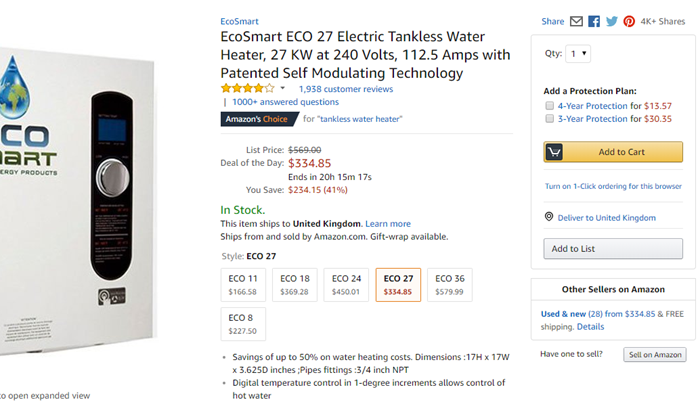5 Simple Rules For Doing Ecommerce SEO For Your Website
By Victoria Greene
May 28, 2018
content, content marketing, customer experience, Customer Journey, digital content, Digital Customer Service, ecommerce, ROI, SEO, UX, Website
Wondering how to approach doing SEO for your ecommerce website? While there are hundreds of potential SEO and UX (user experience) considerations, not all of them are always necessary. It all depends on your budget, business goals, and product niche. If you are looking for some no-nonsense SEO advice — look no further. Here are five simple SEO rules that are guaranteed to bring your ROI and results.
Think About The Customer Journey
Firstly, you’re going to want to look at your website from a customer’s point of view. What pages are they going to land on when they visit your store? You will need to consider what targeted information they will need on their buyer’s journey, such as product features or customer testimonials.
Study your web analytics closely to understand how your customers navigate your site. Use heatmaps to unearth which parts of the page users focus on, and then improve your pages accordingly. Center key information where users’ attention is held the most to maximize response and engagement.
For an example of effective customer UX, consider online retail giant Amazon’s product pages:

Amazon have put considerable thought into their customer’s journey. Their pages are all optimized for the best possible user experience. Their call-to-action is clear and easily identifiable, and they make reviews, alternative purchase options, answered questions and the like readily accessible.
This prevents users getting ‘lost’ on a page, thereby reducing bounce rates. It’s also easy for customers to access relevant information and subsequently make a purchase, streamlining their journey.
Engagement metrics and sales figures do not exist in a bubble and are not separate from your SEO KPIs. Commercials should form an essential part of any ecommerce SEO strategy, as they indicate the efficacy of your website. As such, your SEO KPIs need to be your business KPIs too.
Don’t Forget The Silo
When it comes to ecommerce SEO, silo content is absolutely vital.
Your business needs ancillary content to provide links back to your product and category pages. These would constitute blog posts or product guides which serve as a platform for you to share your knowledge and create value for your brand. Think “best dresses for summer” or “how to use your digital camera.”
Don’t focus solely on your product pages and forget everything else. Instead, you should plan and create an entire editorial calendar that guides your customers through your product’s features and various uses, featuring informative and well-written content. As well as providing a valuable practical element for your customers, it also provides further links back to your product and category pages.
As an example, check out online fashion retailer ASOS’s website:

Style advice, insider tips, industry news — all are there to provide use and value to the customer, as well as links to individual products and categories. Silo content is crucial for your SEO, so don’t neglect it.
Improve Internal Linking
For the crawlers navigating your website, internal links are crucial in helping them find their way around. That means you need to look at the overall structure of your website.
Your internal links should flow downwards in a pyramid shape, as in the diagram below:

In this example, think of the top circle as the home page, and the second row as broad categories such as men, women, children. The row below that constitutes further categories (e.g. jeans, shirts, shoes, etc), and the last row indicates each individual product in that category.
Each category page eventually leads back to the home page, and as such makes it easier for crawlers to navigate your site. This will lend itself to your site’s overall ranking power, as valuable link juice (the value of a hyperlink) is passed on to more pages within your site.
This one is a quick win as far as your SEO is concerned. It’s easy to implement and can be controlled and administered in-house, so a rule worth paying attention to. Capitalize on your internal linking and make sure that both your customer and the search engines can navigate around your site with ease.
Create A Community
If you truly want to achieve great ecommerce SEO, you can’t do it alone. Instead, you will need to rely on a whole community of active users who engage with your brand. Things such as social shares, backlinks, and customer reviews all help signal to search engine crawlers that your website has a significant and viable web presence. As such, they consider it worth paying attention to and worth ranking as well.
To that end, ramp up your social media activity and encourage your followers to like and share your content. User-generated content is a particularly great way of fostering this. You should also ask your customers to leave reviews after making a purchase, with the added incentive of money off their next purchase.
Doing this will help build trust, authority and relevance for your site, factors that search engines will recognize and as a result reward you for.
Focus On The 99%
SEO as a whole is a complex field, and it can be easy to get lost in the little things. But don’t get bogged down by tiny fixes that provide your site with little value. Instead, be sure to focus on the essentials of your SEO strategy.
Keep growing your organic SEO channels in a way that is sustainable and works for your business. Technical SEO is generally fairly easy to implement on most common web environments, but don’t be afraid to seek support from development teams where needed. Rule of thumb: the better the CMS, the better the SEO results!
Create SEO roadmaps and keep on top of project management for larger improvements. Don’t change page structure, URLs, or site design without taking into account SEO considerations.
Ecommerce SEO can seem dense and confusing, but it doesn’t need to be. These rules are easy to follow and simple to implement, and the benefits can be significant. Think about your customer’s journey, ramp up your silo content, and focus on your site’s community — and you’re guaranteed to see some great results.

Victoria Greene
Victoria Greene is a branding consultant and freelance writer. On her blog, VictoriaEcommerce, she shares tips on how new business owners can get their brand off the ground. She is passionate about using her experience to help fellow entrepreneurs succeed.